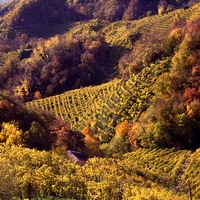It’s no joke. Effective April 1st, Prosecco, the increasingly popular but often very simple-tasting Italian fizz, will be elevated to DOCG status, placing it on the same level as Italy’s most prestigious wines. No fooling — from now on Prosecco will be playing in the same league as Barolo, Brunello, Chianti Classico and the other Italian elites.
placing it on the same level as Italy’s most prestigious wines. No fooling — from now on Prosecco will be playing in the same league as Barolo, Brunello, Chianti Classico and the other Italian elites.
Of course, that same league also includes wines such as Albana di Romagna, Cesanese del Piglio, Sforzato di Valtelina, and a host of others that even the most avid connoisseur would not likely consider the cream of the Italian crop. No one has ever accused authorities in Rome of using logic when identifying DOCG and DOC wines. And it’s important to understand that not all Prosecco will gain DOCG status. Only wines made in the Conegliano e Valdobbiadene zone in the province of Trevisio will merit the distinction.
The rationale for this change, long advocated by the producers’ consortium in Conegliano e Valdobbiadene, is to distinguish authentic, artisanal Prosecco from the sea of more industrial wine on the market. As Giancarlo Vettorello, the consortium’s director, explains, the goal was to create a “quality pyramid” for consumers, with more generic Prosecco at the base, and the best wines at the top.
The problem is that, both in terms of production volume and in terms of point of origin, this pyramid’s base is immense. The new regulations establish a massive DOC zone for Prosecco at large. This newly delimited region includes much of the Veneto and most of Friuli-Venezia Giulia, going all the way to the Slovenian border. The wines made in it clearly threaten to overwhelm the small peak of quality at the top. Moreover, that peak does not simply include wines from one place. The distinction between a first-rate Prosecco and an ordinary one is not necessarily geographical. With this particular bubbly, neither authenticity nor quality is just a matter of locale.
There can be no doubt that the finest Conegliano e Valdobbiadene  Proseccos, particularly those made from grapes grown on the Cartizze hill (the one location that pretty much everyone agrees does merit special recognition), are superlative wines. Customarily off-dry, with pronounced fruit flavors (think pineapple, peach, apple, even banana, in addition to citrus), their focused acidity gives them impressive harmony and balance. At the same time, however, a great deal of Prosecco tastes sugary but charmless. And while tanker trucks full of it come from outside the Conegliano e Valdobbiadene zone, you can find plenty of disappointing wine made from grapes grown within the new DOCG.
Proseccos, particularly those made from grapes grown on the Cartizze hill (the one location that pretty much everyone agrees does merit special recognition), are superlative wines. Customarily off-dry, with pronounced fruit flavors (think pineapple, peach, apple, even banana, in addition to citrus), their focused acidity gives them impressive harmony and balance. At the same time, however, a great deal of Prosecco tastes sugary but charmless. And while tanker trucks full of it come from outside the Conegliano e Valdobbiadene zone, you can find plenty of disappointing wine made from grapes grown within the new DOCG.
That’s why the proverbial jury remains out on the question of whether the new designations represent a change for the better. A great deal of today’s Conegliano e Valdobbiadene Prosecco, even the more expensive and so allegedly prestigious bottlings, are blends of wines made from grapes grown throughout the zone. Perhaps in the future more of them will come from specific locales and so taste more distinctive. But it seems just as likely that the new designation will embolden producers to raise prices without significantly improving the wines. And if that happens, consumers will be the ones being played for this April’s fool.
4
